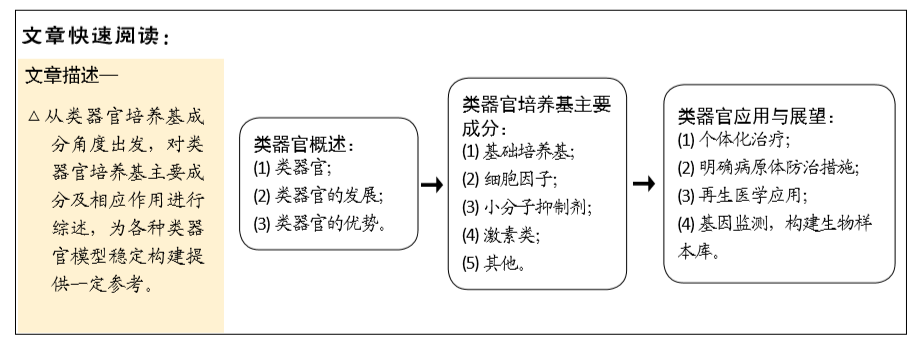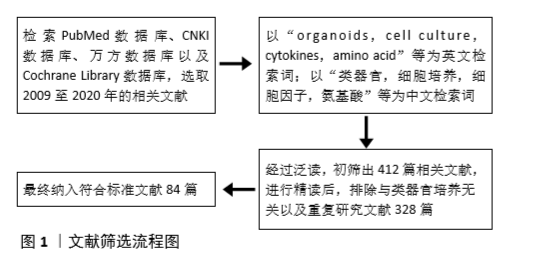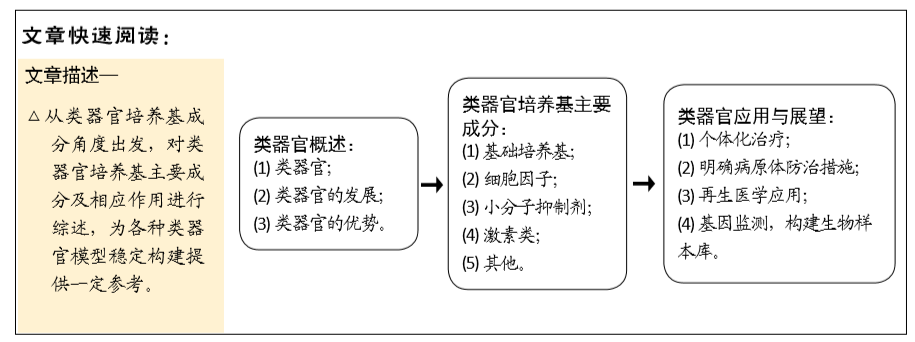[1] FRAPPART PO, HOFMANN TG. Pancreatic Ductal Adenocarcinoma (PDAC) Organoids: The Shining Light at the End of the Tunnel for Drug Response Prediction and Personalized Medicine. Cancers (Basel). 2020;12(10):2750.
[2] DOCTOR A, SEIFERT V, ULLRICH M, et al. Three-Dimensional Cell Culture Systems in Radiopharmaceutical Cancer Research. Cancers (Basel). 2020;12(10):2765.
[3] DROST J, CLEVERS H. Organoids in cancer research. Nat Rev Cancer. 2018;18(7):407-418.
[4] XIAO S, ZHOU L. Gastric Stem Cells: Physiological and Pathological Perspectives. Front Cell Dev Biol. 2020;8:571536.
[5] GILAZIEVA Z, PONOMAREV A, RUTLAND C, et al. Promising Applications of Tumor Spheroids and Organoids for Personalized Medicine. Cancers (Basel). 2020;12(10):2727.
[6] MITTAL R, WOO FW, CASTRO CS, et al. Organ-on-chip models: Implications in drug discovery and clinical applications. J Cell Physiol. 2019;234(6):8352-8380.
[7] WEI K, KORSUNSKY I, MARSHALL JL, et al. Notch signalling drives synovial fibroblast identity and arthritis pathology. Nature. 2020; 582(7811):259-264.
[8] CLINTON J, MCWILLIAMS-KOEPPEN P. Initiation, Expansion, and Cryopreservation of Human Primary Tissue-Derived Normal and Diseased Organoids in Embedded Three-Dimensional Culture. Curr Protoc Cell Biol. 2019;82(1):e66.
[9] YOSHIDA GJ. Applications of patient-derived tumor xenograft models and tumor organoids. J Hematol Oncol. 2020;13(1):4.
[10] LIM SL, DAMNERNSAWAD A, SHYAMSUNDER P, et al. Proteolysis targeting chimeric molecules as therapy for multiple myeloma: efficacy, biomarker and drug combinations. Haematologica. 2019;104(6):1209-1220.
[11] JIN ZB, OKAMOTO S, OSAKADA F, et al. Modeling retinal degeneration using patient-specific induced pluripotent stem cells. PLoS One. 2011; 6(2):e17084.
[12] GAO D, VELA I, SBONER A, et al. Organoid cultures derived from patients with advanced prostate cancer. Cell. 2014;159(1):176-187.
[13] GRENIER K, KAO J, DIAMANDIS P. Three-dimensional modeling of human neurodegeneration: brain organoids coming of age. Mol Psychiatry. 2020;25(2):254-274.
[14] COWAN CS, RENNER M, DE GENNARO M, et al. Cell Types of the Human Retina and Its Organoids at Single-Cell Resolution. Cell. 2020;182(6): 1623-1640.e34.
[15] MILLS RJ, PARKER BL, QUAIFE-RYAN GA, et al. Drug Screening in Human PSC-Cardiac Organoids Identifies Pro-proliferative Compounds Acting via the Mevalonate Pathway. Cell Stem Cell. 2019;24(6):895-907.e6.
[16] WIMMER RA, LEOPOLDI A, AICHINGER M, et al. Human blood vessel organoids as a model of diabetic vasculopathy. Nature. 2019;565(7740): 505-510.
[17] KIM M, MUN H, SUNG CO, et al. Patient-derived lung cancer organoids as in vitro cancer models for therapeutic screening. Nat Commun. 2019;10(1):3991.
[18] MUN SJ, RYU JS, LEE MO, et al. Generation of expandable human pluripotent stem cell-derived hepatocyte-like liver organoids. J Hepatol. 2019;71(5):970-985.
[19] SAITO Y. Establishment of an organoid bank of biliary tract and pancreatic cancers and its application for personalized therapy and future treatment. J Gastroenterol Hepatol. 2019;34(11):1906-1910.
[20] LOOMANS CJM, WILLIAMS GIULIANI N, BALAK J, et al. Expansion of Adult Human Pancreatic Tissue Yields Organoids Harboring Progenitor Cells with Endocrine Differentiation Potential. Stem Cell Reports. 2018;10(3):712-724.
[21] LAU HCH, KRANENBURG O, XIAO H, et al. Organoid models of gastrointestinal cancers in basic and translational research. Nat Rev Gastroenterol Hepatol. 2020;17(4):203-222.
[22] ROSENBLUTH JM, SCHACKMANN RCJ, GRAY GK, et al. Organoid cultures from normal and cancer-prone human breast tissues preserve complex epithelial lineages. Nat Commun. 2020;11(1):1711.
[23] HOMAN KA, GUPTA N, KROLL KT, et al. Flow-enhanced vascularization and maturation of kidney organoids in vitro. Nat Methods. 2019;16(3): 255-262.
[24] GLEAVE AM, CI X, LIN D, et al. A synopsis of prostate organoid methodologies, applications, and limitations. Prostate. 2020;80(6):518-526.
[25] HEIDARI-KHOEI H, ESFANDIARI F, HAJARI MA, et al. Organoid technology in female reproductive biomedicine. Reprod Biol Endocrinol. 2020; 18(1):64.
[26] NANKI Y, CHIYODA T, HIRASAWA A, et al. Patient-derived ovarian cancer organoids capture the genomic profiles of primary tumours applicable for drug sensitivity and resistance testing. Sci Rep. 2020;10(1):12581.
[27] SAITO Y, ONISHI N, TAKAMI H, et al. Development of a functional thyroid model based on an organoid culture system. Biochem Biophys Res Commun. 2018;497(2):783-789.
[28] VASYUTIN I, ZERIHUN L, IVAN C, et al. Bladder Organoids and Spheroids: Potential Tools for Normal and Diseased Tissue Modelling. Anticancer Res. 2019;39(3):1105-1118.
[29] SHACHAM-SILVERBERG V, WELLS JM. Generation of esophageal organoids and organotypic raft cultures from human pluripotent stem cells. Methods Cell Biol. 2020;159:1-22.
[30] 张宏,刘玉琴.培养基的正确制备及使用[J].基础医学与临床,2009, 29(4):446-448.
[31] MAZZOCCHI A, DEVARASETTY M, HERBERG S, et al. Pleural Effusion Aspirate for use in 3D Lung Cancer Modeling and Chemotherapy Screening. ACS Biomater Sci Eng. 2019;5(4):1937-1943.
[32] XU YP, QIU Y, ZHANG B, et al. Zika virus infection induces RNAi-mediated antiviral immunity in human neural progenitors and brain organoids. Cell Res. 2019;29(4):265-273.
[33] ALVAREZ-FLORES MP, HÉBERT A, GOUELLE C, et al. Neuroprotective effect of rLosac on supplement-deprived mouse cultured cortical neurons involves maintenance of monocarboxylate transporter MCT2 protein levels. J Neurochem. 2019;148(1):80-96.
[34] SÜNWOLDT J, BOSCHE B, MEISEL A, et al. Neuronal Culture Microenvironments Determine Preferences in Bioenergetic Pathway Use. Front Mol Neurosci. 2017;10:305.
[35] LI J, GHAZWANI M, LIU K, et al. Regulation of hepatic stellate cell proliferation and activation by glutamine metabolism. PLoS One. 2017; 12(8):e0182679.
[36] HAMID ZA, TAN HY, CHOW PW, et al. The role of n-acetylcysteine supplementation on the oxidative stress levels, genotoxicity and lineage commitment potential of ex vivo murine haematopoietic stem/progenitor cells. Sultan Qaboos Univ Med J. 2018;18(2):e130-e136.
[37] WEDEKEN L, LUO A, TREMBLAY JR, et al. Adult Murine Pancreatic Progenitors Require Epidermal Growth Factor and Nicotinamide for Self-Renewal and Differentiation in a Serum- and Conditioned Medium-Free Culture. Stem Cells Dev. 2017;26(8):599-607.
[38] GUO Q, CHEN S, RAO X, et al. Inhibition of SIRT1 promotes taste bud stem cell survival and mitigates radiation-induced oral mucositis in mice. Am J Transl Res. 2019;11(8):4789-4799.
[39] QI Y, LOHMAN J, BRATLIE KM, et al. Vitamin C and B3 as new biomaterials to alter intestinal stem cells. J Biomed Mater Res A. 2019;107(9):1886-1897.
[40] GAO K, ZHANG T, WANG F, et al. Therapeutic Potential of Wnt-3a in Neurological Recovery after Spinal Cord Injury. Eur Neurol. 2019;81(3-4): 197-204.
[41] XIAO XH, HUANG QY, QIAN XL, et al. Cdc42 Promotes ADSC-Derived IPC Induction, Proliferation, And Insulin Secretion Via Wnt/β-Catenin Signaling. Diabetes Metab Syndr Obes. 2019;12:2325-2339.
[42] 李双,孙倩倩,余丽梅,等.Wnt3a与Wnt5a信号途径转换对造血干细胞衰老的影响[J].基础医学与临床,2018,38(5):703-707.
[43] DATE S, SATO T. Mini-gut organoids: reconstitution of the stem cell niche. Annu Rev Cell Dev Biol. 2015;31:269-289.
[44] LUGLI N, KAMILERI I, KEOGH A, et al. R-spondin 1 and noggin facilitate expansion of resident stem cells from non-damaged gallbladders. EMBO Rep. 2016;17(5):769-779.
[45] NAM MO, HAHN S, JEE JH, et al. Effects of a small molecule R-spondin-1 substitute RS-246204 on a mouse intestinal organoid culture. Oncotarget. 2017;9(5):6356-6368.
[46] DOSSENA M, PIRAS R, CHERUBINI A, et al. Standardized GMP-compliant scalable production of human pancreas organoids. Stem Cell Res Ther. 2020;11(1):94.
[47] 马雨楠,游颖,沈欢欢,等. Noggin基因沉默对BMP和Wnt信号通路表达的影响[J].中国实验动物学报,2016,24(5):475-480.
[48] KUIJK EW, RASMUSSEN S, BLOKZIJL F, et al. Generation and characterization of rat liver stem cell lines and their engraftment in a rat model of liver failure. Sci Rep. 2016;6:22154.
[49] BROUTIER L, MASTROGIOVANNI G, VERSTEGEN MM, et al. Human primary liver cancer-derived organoid cultures for disease modeling and drug screening. Nat Med. 2017;23(12):1424-1435.
[50] ZHOU J, LI C, LIU X, et al. Infection of bat and human intestinal organoids by SARS-CoV-2. Nat Med. 2020;26(7):1077-1083.
[51] XIE Y, PARK ES, XIANG D, et al. Long-term organoid culture reveals enrichment of organoid-forming epithelial cells in the fimbrial portion of mouse fallopian tube. Stem Cell Res. 2018;32:51-60.
[52] ZHANG RR, KOIDO M, TADOKORO T, et al. Human iPSC-Derived Posterior Gut Progenitors Are Expandable and Capable of Forming Gut and Liver Organoids. Stem Cell Reports. 2018;10(3):780-793.
[53] 米杜秋,张路阳,刘强,等.表皮生长因子对胶质瘤干细胞增殖与侵袭的影响[J].解剖科学进展,2019,25(1):70-73.
[54] BOONEKAMP KE, KRETZSCHMAR K, WIENER DJ, et al. Long-term expansion and differentiation of adult murine epidermal stem cells in 3D organoid cultures. Proc Natl Acad Sci U S A. 2019;116(29):14630-14638.
[55] DRAVIS C, SPIKE BT, HARRELL JC, et al.ox10 Regulates Stem/Progenitor and Mesenchymal Cell States in Mammary Epithelial Cells. Cell Rep. 2015;12(12):2035-2048.
[56] FUJII M, MATANO M, TOSHIMITSU K, et al. Human Intestinal Organoids Maintain Self-Renewal Capacity and Cellular Diversity in Niche-Inspired Culture Condition. Cell Stem Cell. 2018;23(6):787-793.e6.
[57] CHUNG MI, BUJNIS M, BARKAUSKAS CE, et al. Niche-mediated BMP/SMAD signaling regulates lung alveolar stem cell proliferation and differentiation. Development. 2018;145(9):dev163014.
[58] BEUMER J, ARTEGIANI B, POST Y, et al. Enteroendocrine cells switch hormone expression along the crypt-to-villus BMP signalling gradient. Nat Cell Biol. 2018;20(8):909-916.
[59] YIP HYK, TAN CW, HIROKAWA Y, et al. Colon organoid formation and cryptogenesis are stimulated by growth factors secreted from myofibroblasts. PLoS One. 2018;13(6):e0199412.
[60] MÚNERA JO, WELLS JM. Generation of Gastrointestinal Organoids from Human Pluripotent Stem Cells. Methods Mol Biol. 2017;1597:167-177.
[61] WU B, LI L, LI B, et al. Activin A and BMP4 Signaling Expands Potency of Mouse Embryonic Stem Cells in Serum-Free Media. Stem Cell Reports. 2020;14(2):241-255.
[62] PATEL M, VELAGAPUDI C, BURNS H, et al. Mouse Metanephric Mesenchymal Cell-Derived Angioblasts Undergo Vasculogenesis in Three-Dimensional Culture. Am J Pathol. 2018;188(3):768-784.
[63] IYER RK, ODEDRA D, CHIU LL, et al. Vascular endothelial growth factor secretion by nonmyocytes modulates Connexin-43 levels in cardiac organoids. Tissue Eng Part A. 2012;18(17-18):1771-1783.
[64] SONG L, YUAN X, JONES Z, et al. Assembly of Human Stem Cell-Derived Cortical Spheroids and Vascular Spheroids to Model 3-D Brain-like Tissues. Sci Rep. 2019;9(1):5977.
[65] JANGPHATTANANONT N, SATO H, IMAMURA R, et al. Distinct Localization of Mature HGF from its Precursor Form in Developing and Repairing the Stomach. Int J Mol Sci. 2019;20(12):2955.
[66] LIN Y, FANG ZP, LIU HJ, et al. HGF/R-spondin1 rescues liver dysfunction through the induction of Lgr5+ liver stem cells. Nat Commun. 2017; 8(1):1175.
[67] YOO SY, YOO JY, KIM HB, et al. Neuregulin-1 Protects Neuronal Cells Against Damage due to CoCl2-Induced Hypoxia by Suppressing Hypoxia-Inducible Factor-1α and P53 in SH-SY5Y Cells. Int Neurourol J. 2019;23(Suppl 2):S111-118.
[68] MAENHOUDT N, DEFRAYE C, BORETTO M, et al. Developing Organoids from Ovarian Cancer as Experimental and Preclinical Models. Stem Cell Reports. 2020;14(4):717-729.
[69] JARDÉ T, CHAN WH, ROSSELLO FJ, et al. Mesenchymal Niche-Derived Neuregulin-1 Drives Intestinal Stem Cell Proliferation and Regeneration of Damaged Epithelium. Cell Stem Cell. 2020;27(4):646-662.e7.
[70] YOSHIDA T, SINGH AK, BISHAI WR, et al. Organoid culture of bladder cancer cells. Investig Clin Urol. 2018;59(3):149-151.
[71] LI Y, LIU Y, LIU B, et al. A growth factor-free culture system underscores the coordination between Wnt and BMP signaling in Lgr5+ intestinal stem cell maintenance. Cell Discov. 2018;4:49.
[72] YE P, CHIANG YJ, QI Z, et al. Tankyrases maintain homeostasis of intestinal epithelium by preventing cell death. PLoS Genet. 2018;14(9): e1007697.
[73] 俞晓丽,蒲静,罗晓强,等.Rho/ROCK抑制剂Y27632对小鼠腔前卵泡体外培养的影响[J].宁夏医科大学学报,2019,41(8):767-772.
[74] ZHANG C, GUO H, YANG C, et al. The biological behavior optimization of human periodontal ligament stem cells via preconditioning by the combined application of fibroblast growth factor-2 and A83-01 in in vitro culture expansion. J Transl Med. 2019;17(1):66.
[75] GARGETT CE, GURUNG S, DARZI S, et al. Tissue engineering approaches for treating pelvic organ prolapse using a novel source of stem/stromal cells and new materials. Curr Opin Urol. 2019;29(4):450-457.
[76] AOKI H, YAMASHITA M, HASHITA T, et al. Efficient differentiation and purification of human induced pluripotent stem cell-derived endothelial progenitor cells and expansion with the use of inhibitors of ROCK, TGF-β, and GSK3β. Heliyon. 2020;6(3):e03493.
[77] VAN DER JEUGHT M, HEINDRYCKX B, O’LEARY T, et al. Treatment of human embryos with the TGFβ inhibitor SB431542 increases epiblast proliferation and permits successful human embryonic stem cell derivation. Hum Reprod. 2014;29(1):41-48.
[78] HU L, PU Q, ZHANG Y, et al. Expansion and maintenance of primary corneal epithelial stem/progenitor cells by inhibition of TGFβ receptor I-mediated signaling. Exp Eye Res. 2019;182:44-56.
[79] MA R, MORSHED SA, LATIF R, et al. Thyroid cell differentiation from murine induced pluripotent stem cells. Front Endocrinol (Lausanne). 2015;6:56.
[80] LEE Y, URBANSKA AM, HAYAKAWA Y, et al. Gastrin stimulates a cholecystokinin-2-receptor-expressing cardia progenitor cell and promotes progression of Barrett’s-like esophagus. Oncotarget. 2017; 8(1):203-214.
[81] SAITO Y, MURAMATSU T, KANAI Y, et al. Establishment of Patient-Derived Organoids and Drug Screening for Biliary Tract Carcinoma. Cell Rep. 2019;27(4):1265-1276.e4.
[82] GLASS NR, TAKASAKO M, ER PX, et al. Multivariate patterning of human pluripotent cells under perfusion reveals critical roles of induced paracrine factors in kidney organoid development. Sci Adv. 2020;6(2):eaaw2746.
[83] WANG X, NI C, JIANG N, et al. Generation of liver bipotential organoids with a small-molecule cocktail. J Mol Cell Biol. 2020;12(8):618-629.
[84] JACOB F, PATHER SR, HUANG WK, et al. Human Pluripotent Stem Cell-Derived Neural Cells and Brain Organoids Reveal SARS-CoV-2 Neurotropism Predominates in Choroid Plexus Epithelium. Cell Stem Cell. 2020;27(6):937-950.e9.
|


